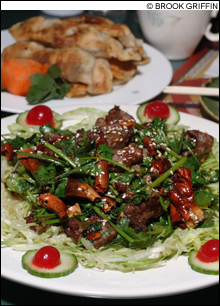 This one is tricky. It is both the best and the worst Chinese restaurant I’ve reviewed in many years. Certain Beijing specials, typically on the whiteboard, are wonderfully delicious. Other items that many restaurants do well are presented here in sub-competent fashion. I’m used to the idea that no one opens a Chinese restaurant without being prepared to serve any Chinese dish that any American customer has ever heard of. I’m also used to the idea that one has to discover a chef’s real specialties. And I’ve certainly seen chefs in Chinese restaurants take a somewhat casual attitude toward Chinese-American dishes or those from the “wrong” region. What I’m not used to is the same kitchen producing the greatest red-cooked whole-fish platter I’ve ever tasted, as well as underfried salt-and-pepper squid and a vegetable stir-fry sitting in a serious puddle of oil. It’s a small kitchen, and the chef is young, so I attribute these results to immaturity. But when some dishes are so good, it’s hard to argue that the chef should grow up. Maybe he shouldn’t.
This one is tricky. It is both the best and the worst Chinese restaurant I’ve reviewed in many years. Certain Beijing specials, typically on the whiteboard, are wonderfully delicious. Other items that many restaurants do well are presented here in sub-competent fashion. I’m used to the idea that no one opens a Chinese restaurant without being prepared to serve any Chinese dish that any American customer has ever heard of. I’m also used to the idea that one has to discover a chef’s real specialties. And I’ve certainly seen chefs in Chinese restaurants take a somewhat casual attitude toward Chinese-American dishes or those from the “wrong” region. What I’m not used to is the same kitchen producing the greatest red-cooked whole-fish platter I’ve ever tasted, as well as underfried salt-and-pepper squid and a vegetable stir-fry sitting in a serious puddle of oil. It’s a small kitchen, and the chef is young, so I attribute these results to immaturity. But when some dishes are so good, it’s hard to argue that the chef should grow up. Maybe he shouldn’t.
The easiest system is to simply never order off the regular menu. Stick with the whiteboard specialties, and you may accumulate some extra oil, but everything will taste pretty great. The greatest I had was the “homestyle red braised whole fish” ($12.95). The fish was a small snapper or bass, exquisitely fresh and sweet. The sauce was soy-savory, and richly spiced with pieces of cassia bark as well as chunks of ginger and garlic. My favorite part of the dish, though, was the cubes of silken tofu and black mushrooms that absorbed the sauce.
Another one to grab off the board is hot-and-spicy crab ($15.95). Again, the seafood is impeccable, and the pepper is a slow burner that gives you time to appreciate the crab-ginger-scallion flavor before it hits. I ate these down to picking out the bits of roe clinging to the shells.
Homestyle eggplant ($7.95) looked like a failed stir-fry: oil puddled in the bottom of a dish of eggplant cubes, chunks of fresh tomato, red and green bell-pepper slices, and onions. But someone knows how to buy a really good eggplant and then how to cook it. Even the winter tomatoes in this dish were good eating. Another night’s “eggplant, potato, tomato” dish ($7.95) was similar, except that chunks of potato — not typical of Chinese-restaurant food — worked almost as well as eggplant in this kind of fresh, hot stir-fry. A whiteboard special on chicken and chili ($10.95), which is on the printed menu as well, was dangerously hot, but the dried peppers were visible, so diners can avoid sudden death.
This place offers a lot of appetizers, and even some of the regular-menu ones are good. “Chinese hamburger” ($2.50) is nothing of the kind. It’s a dense sesame-bread “bun” filled with cold, sliced, five-spice beef, some of it a little gristly, as is the Chinese taste. If this troubles you, just don’t look. Take little bites as though it actually is a hamburger, and you’ll enjoy the flavors.
Handmade dumplings come in vegetable ($5.95), pork and cabbage ($5.25), pork and leek ($5.95), and pork-leek-shrimp ($5.95). I worked through most of them, and none of the fillings were strong enough to overcome the heavy steamed dough of the dumplings. On the other hand, the “open-mouth dumplings” ($3.95/five; $6.95/10) are the same dough and pork-ginger filling you’ll find in anyone’s Peking ravioli, but with an elongated shape — think flattened tubes with some filling showing through at each end — somehow pan-fried into the best Peking ravioli I’ve had in years. Smoked rabbit ($4.95/small; $7.95/large) tastes not unlike any other red-cooked cold appetizer — the filling of a “Chinese hamburger,” say, with a light tea-smoke job — but there were a lot of small bony pieces. Chicken wings ($3.95/small; $6.25/large) are not on the menu for the most discerning Chinese-food enthusiasts, but there were four whole ones decently deep-fried without as much five-spice powder as I prefer. Vegetable rolls ($2.95) were a couple of homemade spring rolls — greasy, but with a fresh-vegetable filling that didn’t overplay the cabbage.
So what didn’t impress? Well, the low point was probably that order of “salt & peppered squid” ($10.95), a Hong Kong dish that usually gets serious treatment if offered at all. The squid was fresh enough, but the heavy breading wasn’t even fried out of flouriness, and all the spice was in a dribble of chili flakes and scallions applied on top. Sautéed string beans ($7.95) had the same chili-scallion sauce and too much oil. An order of plain fried rice ($6.95) was white with a few cubed vegetables and enough oil for three such orders. Barely edible.